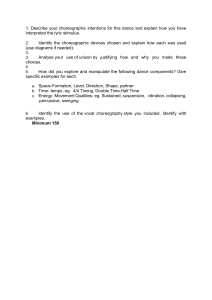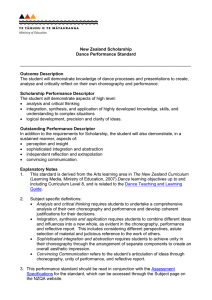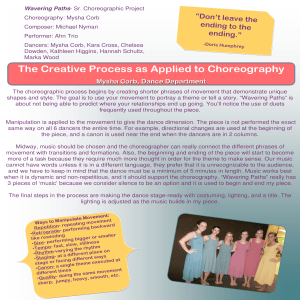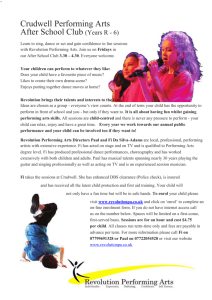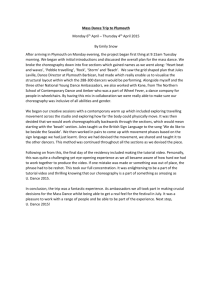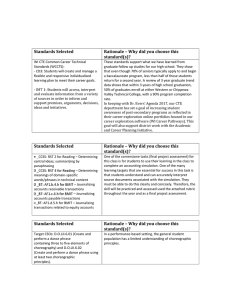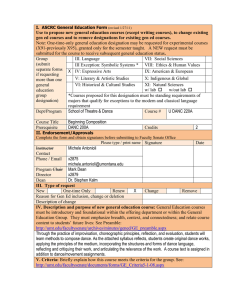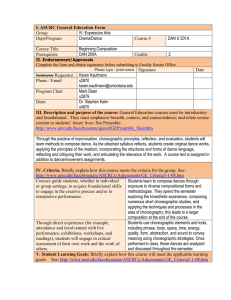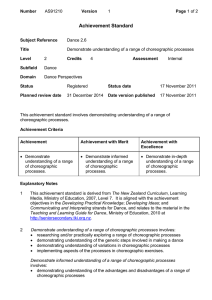SSP4043 Research in Performance Practice
advertisement
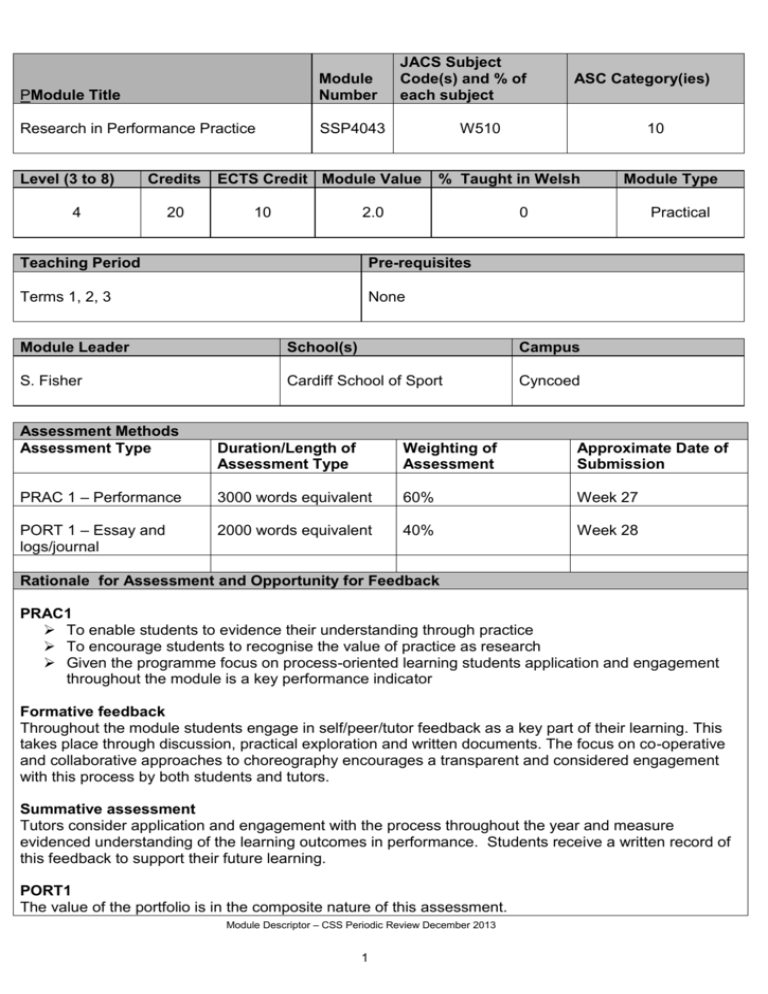
PModule Title Module Number Research in Performance Practice SSP4043 Level (3 to 8) Credits 4 20 JACS Subject Code(s) and % of each subject W510 ECTS Credit Module Value 10 ASC Category(ies) 10 % Taught in Welsh 2.0 0 Teaching Period Pre-requisites Terms 1, 2, 3 None Practical Module Leader School(s) Campus S. Fisher Cardiff School of Sport Cyncoed Assessment Methods Assessment Type Module Type Duration/Length of Assessment Type Weighting of Assessment Approximate Date of Submission PRAC 1 – Performance 3000 words equivalent 60% Week 27 PORT 1 – Essay and logs/journal 2000 words equivalent 40% Week 28 Rationale for Assessment and Opportunity for Feedback PRAC1 To enable students to evidence their understanding through practice To encourage students to recognise the value of practice as research Given the programme focus on process-oriented learning students application and engagement throughout the module is a key performance indicator Formative feedback Throughout the module students engage in self/peer/tutor feedback as a key part of their learning. This takes place through discussion, practical exploration and written documents. The focus on co-operative and collaborative approaches to choreography encourages a transparent and considered engagement with this process by both students and tutors. Summative assessment Tutors consider application and engagement with the process throughout the year and measure evidenced understanding of the learning outcomes in performance. Students receive a written record of this feedback to support their future learning. PORT1 The value of the portfolio is in the composite nature of this assessment. Module Descriptor – CSS Periodic Review December 2013 1 This is realised in two distinct outcomes: Students demonstrate their learning in a variety of ways (written, verbal, practice) Students transfer their learning throughout the portfolio elements, between points of assessment within the module and across modules studied. Formative feedback The learning experiences within the taught module content offers substantial and on-going opportunities for verbal and written feedback. This feedback is provided by self/peer and tutor, and supplemented by individual tutorials as requested. Summative assessment Tutors consider application and engagement with portfolio elements to measure evidenced understanding of the learning outcomes. Each element is designed to ensure the portfolio as a whole is cohesive in addressing these outcomes. Students receive individual written feedback aligned to the assessment criteria, recognising achievement and identifying skills to improve. Aim(s) This modules aims to: Introduce students to the principles of composition through applied creative practice Introduce students to the basic knowledge, understanding and skills of the processes of experimention as a fundamental tool within collaborative choreographic practice exploration and Introduce students understanding of research based practice Consider the basic principles of performance in the realisation of an idea Develop students ability to communicate physically, aurally and through the written word Learning Outcomes By the end of this module students should be able to: Demonstrate and apply an understanding of the principles of composition and choreographic processes Evidence a security in the processes of dance exploration and experimentation Recognise the value of working collaboratively Engage in the processes of research to inform an idea Evidence the principles of performance in the role of a performer Demonstrate an understanding of evaluative processes to inform practice through contribution to discussion, self & peer evaluation and written reflection Module Descriptor – CSS Periodic Review December 2013 2 Learning and Teaching Methods: Range of learning methods (including directed study) and expected scheduled contact time on each: Learning Method Studio based learning Preparation for performance Guided independent practice Independent research Independent practice / research Rationale To facilitate experiential learning and application of theory to practice. The delivery approach is tutor led with a focus on collaborative approaches to learning. Students have the opportunity to explore individually, in small groups and collectively. Where appropriate students engage in workshops led by industry based practitioners. At the end of the teaching year students participate in intensive rehearsals culminating in a public performance offering an opportunity to work in a professional context and apply their learning in a professional arena. Throughout the year students are set creative tasks to explore outside of class time either individually or with peers. This allows students to develop their choreographic practice and learn how to work effectively with others. Students begin to take responsibility for furthering their research independently and ensuring understanding of the module content. Given the fundamental connection to performance students are encouraged to attend performances and workshops in a variety of contexts. Indicative Content Exploration of compositional principles and choreographic processes Exploration and experimentation of processes and ideas Collaborative processes Research informed practice Evaluative processes Realisation through performance Module Descriptor – CSS Periodic Review December 2013 3 Type of contact (scheduled/non contact) Scheduled Total hours 72 Scheduled 30 non contact 20 non contact 30 non contact 50 Recommended Reading & Required Reading Required Reading: Blom, L.A. & Chaplin, L.T. (1989) The Intimate Act of Choreography: London: Dance Books. Burrows, J. (2010) A Choreographer’s Handbook. London & New York: Routledge. [eBook available] Smith-Autard, J. M. (2010) Dance Composition. 6th ed. London: Methuen Drama. [eBook available] Recommended Reading: Blom, L.A. & Chaplin, L.T. (2000) The Moment of Movement: Dance Improvisation. Pittsburgh: University of Pittsburgh Press. Ellfeldt, L. (1988) A Primer for Choreographers. Rev. ed. Illinois: Waveland Press. H’Doubler, M.N. (1998) Dance: A Creative Art Experience. 3rd ed. Wisconsin: University of Wisconsin Press. Humphrey, D. & Pollack, B. (1997) The Art of Making Dances. London: Dance Books. Lavender, L. (1996) Dancers Talking Dance: Critical Evaluation in the Choreography Class. Champaign: Human Kinetics. Minton, S. C. (2007) Choreography: A Basic Approach Using Improvisation. 3rd ed. Champaign: Human Kinetics. Preston-Dunlop, V. (1998) Looking at Dances: A Choreological Perspective on Choreography. Ightham: Verve Publishing. Tufnell, M. & Crickmay, C. (1993) Body Space Image: Notes Towards Improvisation and Performance. London: Dance Books. Access to Specialist Requirements Access to AV equipment and resources; Learning Resource Centre and Blackboard; Workshops with guest artists and companies; Dance studio for independent practice. Module Descriptor – CSS Periodic Review December 2013 4
